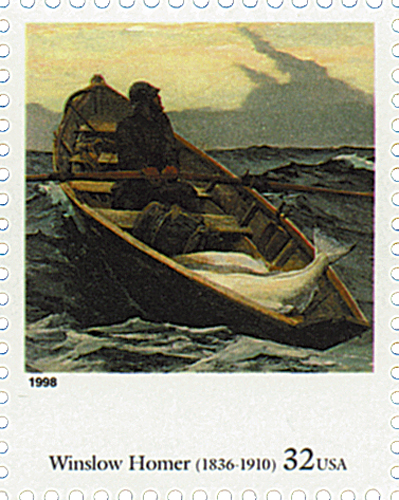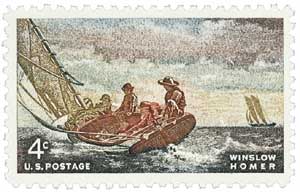
# 4473 FDC - 2010 44c Winslow Homer
U.S. #4473
2010 44¢ Winslow Homer
American Treasures Series
City: Richmond, VA
Birth Of Artist Winslow Homer
Homer’s mother was a talented watercolorist that began teaching him to paint at a young age. Though Homer was an average student, he proved himself to be a talented artist early on.

Homer’s father was always anxious to make money. He tried out different business ventures, moved to California for the gold rush, and even went to Europe to raise money for get-rich-quick schemes. Then, after Homer graduated from high school, his father got him an apprenticeship with a Boston lithographer. Though it provided him with good experience, Homer grew tired of the repetitive work of engraving sheet music covers. He began working as a freelance artist two years later and turned down an offer for a full-time position with Harper’s Weekly. Homer claimed, “From the time I took my nose off that lithographic stone I have had no master, and never shall have any.”
Homer worked as a successful freelance illustrator for the next 20 years. His work appeared in Ballou’s Pictorial and Harper’s Weekly. Most of his illustrations during this time were of urban and country scenes. In the coming years, Homer moved to Belmont, Massachusetts and later New York City. It was in New York that he opened his studio and briefly attended the National Academy of Design.
Homer showed immense skill painting with oils, even though he’d largely been training himself for about a year. His mother tried to raise money to send him to Europe to study, but he then received another job offer. Harper’s Weekly wanted to send him to the front lines of the Civil War. Homer obliged and sketched (and later painted) camp life as well as intense battle scenes. Most of his Civil War paintings picture George B. McClellan and his troops along the Potomac River. He also illustrated women in wartime, showing the effect of the war on the home front.
U.S. #4473
2010 44¢ Winslow Homer
American Treasures Series
City: Richmond, VA
Birth Of Artist Winslow Homer
Homer’s mother was a talented watercolorist that began teaching him to paint at a young age. Though Homer was an average student, he proved himself to be a talented artist early on.

Homer’s father was always anxious to make money. He tried out different business ventures, moved to California for the gold rush, and even went to Europe to raise money for get-rich-quick schemes. Then, after Homer graduated from high school, his father got him an apprenticeship with a Boston lithographer. Though it provided him with good experience, Homer grew tired of the repetitive work of engraving sheet music covers. He began working as a freelance artist two years later and turned down an offer for a full-time position with Harper’s Weekly. Homer claimed, “From the time I took my nose off that lithographic stone I have had no master, and never shall have any.”
Homer worked as a successful freelance illustrator for the next 20 years. His work appeared in Ballou’s Pictorial and Harper’s Weekly. Most of his illustrations during this time were of urban and country scenes. In the coming years, Homer moved to Belmont, Massachusetts and later New York City. It was in New York that he opened his studio and briefly attended the National Academy of Design.
Homer showed immense skill painting with oils, even though he’d largely been training himself for about a year. His mother tried to raise money to send him to Europe to study, but he then received another job offer. Harper’s Weekly wanted to send him to the front lines of the Civil War. Homer obliged and sketched (and later painted) camp life as well as intense battle scenes. Most of his Civil War paintings picture George B. McClellan and his troops along the Potomac River. He also illustrated women in wartime, showing the effect of the war on the home front.








